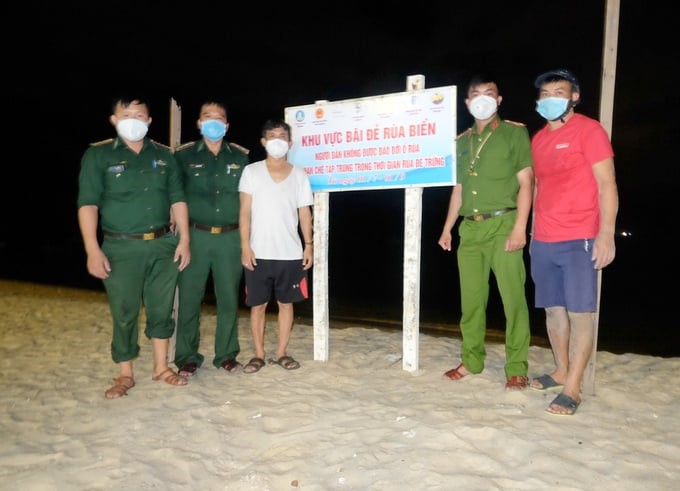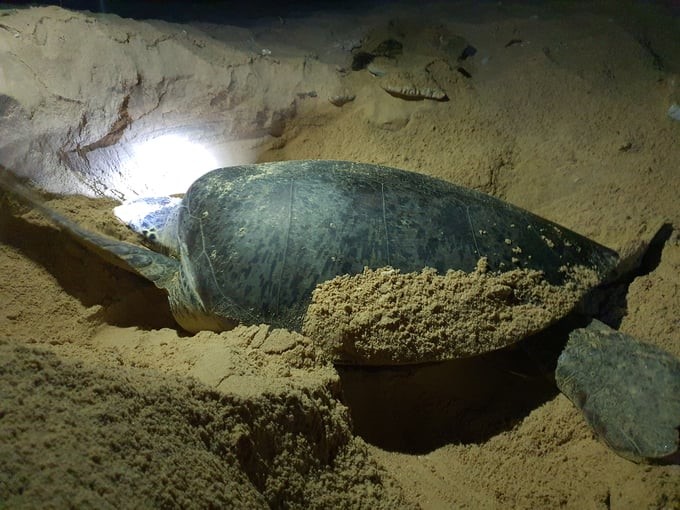May 24, 2025 | 16:26 GMT +7
May 24, 2025 | 16:26 GMT +7
Hotline: 0913.378.918
May 24, 2025 | 16:26 GMT +7
Hotline: 0913.378.918
Binh Dinh is a locality that has done well in protecting sea turtles over the past 15 years. According to the Binh Dinh Sub-Department of Fisheries, in 2007, this province's functional sector, under the consultation of Ms. Gail Berbie, a volunteer from New Zealand’s VSA Organization, implemented a survey on the spawning grounds of sea turtles in Nhon Hai commune (Quy Nhon city). As a result, a turtle spawning ground was discovered at Hon Kho (Nhon Hai commune). Sea turtles laying in Nhon Hai are green turtles, whose scientific name is Chelonia mydas.
Since then, to preserve sea turtles, Binh Dinh's agriculture sector has coordinated with the International Union for Conservation of Nature (IUCN) to mobilize local fishermen to protect and preserve spawning grounds for sea turtles.

A sea turtle protection volunteer and an official of the Binh Dinh Sub-Department of Fisheries released baby turtles back to the sea in 2013. Photo: V.D.T.
Mr. Nguyen Ton Xuan Sang, Director of Nhon Hai Tourism and Fisheries Service Cooperative (Quy Nhon city, Binh Dinh), member of the Community Group to protect aquatic resources and a volunteer to protect local sea turtles, said: Every year, from June to August on the lunar calendar, is the spawning season of sea turtles. Previously, when Nhon Hai fishing village was still a coastal commune with deserted sand banks, sea turtles chose this place as a place to give birth.
But since Nhon Hai fishermen have strongly developed near-shore fishing, human and boat activities have taken away the desolation of these sand banks, meaning sea turtles have lost their spawning grounds. From then on, when the spawning season comes, the mother turtles flock to Hon Kho, an island located separately from the residential area of Nhon Hai commune, to give birth in peace.
To preserve sea turtles, the Binh Dinh fisheries industry has coordinated with IUCN to mobilize local fishermen to protect and preserve spawning grounds for sea turtles. Besides, the Binh Dinh fisheries industry also regularly organizes seminars and training around the content of sea turtle conservation for officials, fishermen in coastal localities, business people and traders of aquatic products, and related businesses.
"The efforts of the functional sector, the local government, and related branches have touched people's hearts. Coastal people not only raised their awareness of protecting sea turtles by no longer catching turtles for sale as before but also knew how to protect turtle eggs. They no longer took eggs home to boil, eat, or sell, but every time they discovered a clutch of eggs, they immediately reported it to the functional sector or local government for protection. Even many people, when encountering sea turtles being sold in rural markets, immediately spend money to buy them and then hand them over to the functional sector," said Mr. Tran Van Vinh, Deputy Director of Binh Dinh Sub-Department of Fisheries.

Sea turtle protection volunteer group of Nhon Hai commune (Quy Nhon city, Binh Dinh) Photo: V.D.T.
In mid-2023, Binh Dinh Sub-Department of Fisheries coordinated with the People's Committee of Nhon Hai commune (Quy Nhon city) and two businesses operating in the tourism field, namely Avani Quy Nhon Resort and Anantara Quy Nhon Villas, to organize a communication campaign on preserving sea turtle spawning grounds in the Con Cape beach area (Nhon Hai commune), with a large number of local people joining.
According to Mr. Tran Van Vinh, Nhon Hai Peninsula commune is the only place in Binh Dinh where sea turtles come to the beach to lay eggs. Sea turtle conservation activities began in Nhon Hai commune in 2007. In 2010, the Binh Dinh Sub-Department of Fisheries implemented community-based conservation activities for sea turtle spawning grounds, established a volunteer group to protect sea turtle spawning grounds, and implemented many dissemination activities to raise public awareness.
Thanks to the above-mentioned activities, awareness among the Binh Dinh coastal fishermen community, especially people in Nhon Hai commune (Quy Nhon city), of protecting aquatic resources, especially sea turtle conservation, has obviously increased. However, the current sea turtle conservation in Nhon Hai commune faces a big challenge, which is that economic and residential projects are causing the risk of gradually losing sea turtle spawning grounds.

Sea turtles dig sand to make nests to protect their eggs. Photo: V.D.T.
“Therefore, preserving spawning grounds for sea turtles is very necessary. To effectively carry out this work, we need to further promote forms of communication and spread messages widely in the community about the importance of preserving sea turtles and protecting the environment and marine ecosystem," said Mr. Tran Van Vinh, Deputy Director of the Binh Dinh Sub-Department of Fisheries.
In 2022, the Quy Nhon City People's Committee issued a document agreeing on the temporary planning project for Nhon Hai commune beach. Accordingly, the total planning area along the beach located on the water surface is 14.67 hectares, divided into three areas: the area for anchoring boats, fishing net tools, and baskets; the area for beach swimming and tourist services; and the area for turtle spawning grounds located at Con Cape in Hai Dong village (Nhon Hai commune). Of which, the area for turtle spawning grounds has an area of more than 9,856 m2. All swimming, playing, and entertainment activities are strictly prohibited in this area, which only serves turtles laying eggs.
Translated by Huyen Vu Thu

(VAN) The People's Committee of Tra Vinh province has approved an adjustment to the investment policy for the Green Hydrogen Plant project, increasing its area to approximately 52.76 hectares.
![Reducing emissions from rice fields: [2] Farmers’ commitment to the soil](https://t.ex-cdn.com/nongnghiepmoitruong.vn/608w/files/news/2025/05/05/dsc08881jpg-nongnghiep-140632.jpg)
(VAN) Clean rice cultivation model in Thuong Tan commune, Bac Tan Uyen district, is assisting local residents in achieving sustainable agriculture by substantially reducing costs, increasing productivity, and protecting the environment.

(VAN) At the conference to disseminate Resolution No. 68, AgriS introduced its digital agricultural ecosystem and reaffirmed its commitment to accompanying the Government in promoting private sector development and sustainable agriculture.

(VAN) 'Blue Ocean - Blue Foods' initiative is designed to restore marine ecosystems and establish sustainable livelihoods for local communities by cultivating a minimum of 1,000 hectares of cottonii seaweed in the first three years.
/2025/05/21/4642-3-112707_603.jpg)
(VAN) The V-SCOPE project has made direct contributions to three out of six pillars of the Comprehensive Strategic Partnership between Vietnam and Australia.

(VAN) Facing the threat of rabies spreading to the community, Gia Lai province urgently carries out measures to vaccinate dogs and cats on a large scale.

(VAN) Disease-free livestock farming not only protects livestock herds but also stabilizes production and livelihoods for many farmers in Tuyen Quang.